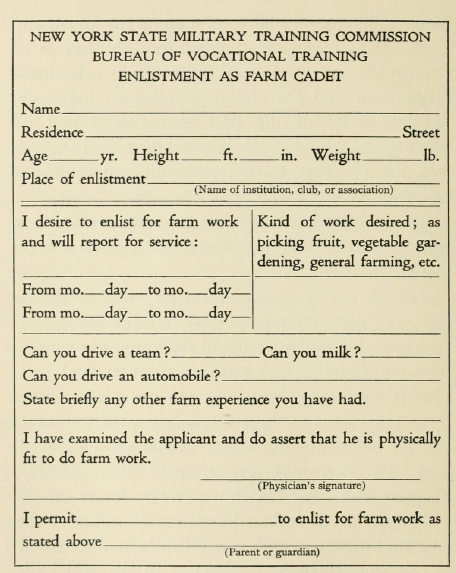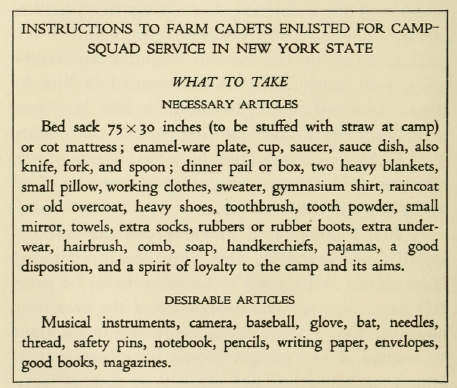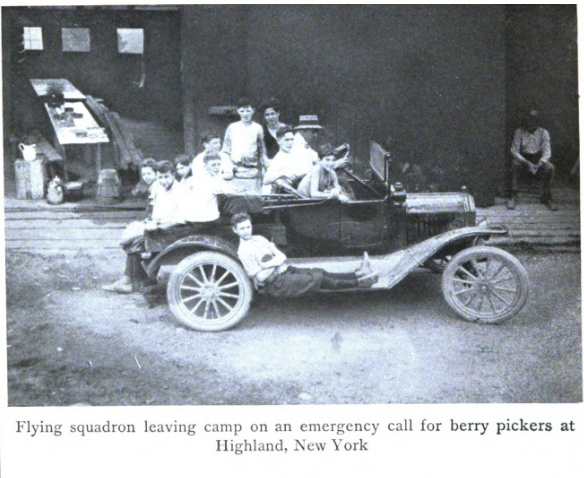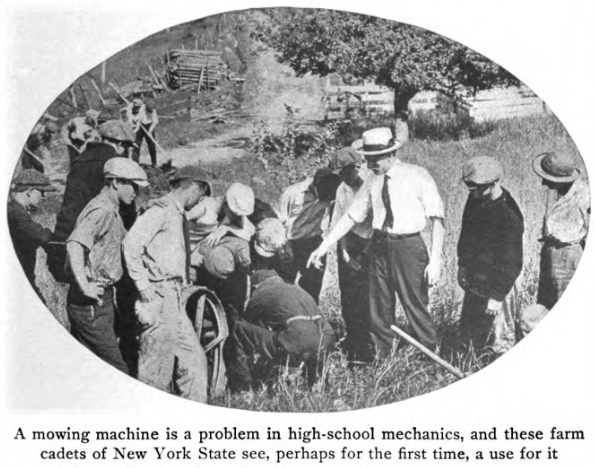Many schools have canceled classes for an indefinite period of time because of the coronavirus outbreak. There was another era when students were excused from school for an extended period of time. The reason for the lapse in school was not because of health concerns; it was to work in agriculture to produce food during World War I. In this Friday Footnote we will learn about the Farm Cadet program in New York state.
In the Report on Secondary Education in the State of New York For the School Year Ending July 31, 1917, Charles F. Wheelock, Assistant Commissioner for Secondary Education in New York state reported (p. 7-8):
The entry of the United States into the great world war in April 1917 was a matter of vital importance and far-reaching influence to the high schools of the State… Soon after the declaration of war, the danger of the lack of sufficient food was brought forcibly to the attention of the country. In April a conference called by the President of the University, was held in the Education Building to consider what the schools could do in the way of national service. This conference was attended by leading college presidents, members of the State Examinations Board, and others. It was addressed by the Governor of the State, the Commissioner of Agriculture, Charles S. Wilson, George W. Perkins and others. After due deliberation by the conference, resolutions were adopted and recommendations made to the Department.
It was decided to release high school pupils for service, to excuse those so released from the regular Regents examinations and to give credit for the work on the certificate of the schools that satisfactory standards in class work had been maintained to the time of release.
Immediately after this meeting letters were sent to schools with management information. The letter stated (Wheelock, p. 8) that:
… any pupil who enlists for military service or who enlists for and renders satisfactory agricultural or industrial service will be credited with the work of the present term without examination on the certificate of the school that his work up to the time of enlistment is satisfactory.
The boys (and girls) who volunteered for farm work were known as Farm Cadets. Over 30,000 farm cadets volunteered during 1917. There were two versions of the Farm Cadet program – one was for high school students under the age of 16. The other version of the Farm Cadet program was for students age 16-19.
Farm Cadet Program for Students Under the Age of 16
The guidelines for the program stated (Wheelock, 1918, p. 9) that “The consent of the local school principal or superintendent and of the parents of the children must be obtained in every case before the pupils are released from school to engage in service.” Parents and school authorities were advised to investigate the working conditions of the placement and agree to the hours of labor, remuneration to be received, living arrangements, and other factors associated with the work before the pupil would be released. The student had to be in good academic standing to be in the Farm Cadets.
Many of the farm cadets came from farms and could work on their family farm (of the 30,000 Farm Cadets, 14,500 worked on their home farms). Others often worked for neighbors or people in the community. Girls were allowed in the Farm Cadets on the condition they (Wheelock, 1918, p. 9) “… be released for service on the farms and then only when they may be employed in their homes or so near to their own homes that they may be under the supervision of their parents.” Many of the Farm Cadets received no specialized training (but there were some exceptions).
The Farm Cadets had to provide weekly reports of their farm service to their schools. Cadets were visited by the teachers of agriculture from the various state colleges or secondary schools if there was an agriculture program and by district superintendents and directors of agriculture where the agricultural teachers were not available.
Following is a weekly report provided by a Farm Cadet (Wheelock, 1918, p. 12):
One boy working at home reported as follows: for the week of July 8th: Sunday, did chores 1 hour; Monday, cultivated corn 10 hours; Tuesday, cultivated potatoes and worked in garden 10 hours, Wednesday, cultivated potatoes and ploughed for buckwheat 10 hours; Thursday, harrowed 10 hours; Friday, harrowed and ploughed 10 hours; Saturday, harrowed and drilled buckwheat 10 hours.
The Farm Cadet Program for Students 16 years and older
Three different groups were involved in operating the Farm Cadet program for the older students – the New York Food Supply Commission, the State Education Department, and the State Military Training Commission. While the Farm Cadet guidelines for under 16-year-old students were somewhat simple, the over 16 guidelines were more rigorous. Students were required to “enroll” in the Farm Cadet program. Local school teachers served as “enrollment” officers and were encouraged to fill out the form for the students so they would be legible (Stowell, 1919). A physician had to certify the candidate was healthy enough to do strenuous farm work. The enlistment form is shown below.
The state of New York was divided into six zones. Each zone had a placement office to facilitate Farm Cadet placements. Meetings were held in each zone with zone supervisors, Farm Bureau managers (remember the Farm Bureau was synonymous with the Extension Service) and farmers and fruit growers to identify labor needs.
Unlike similar programs in other states, the cadets did not wear uniforms; they wore their civilian clothes. However, 16-year boys received a chevron with one member of the state seal (after completing 30 days of service), 17-year-old boys received a chevron with two members, while 18-year-old boys received a chevron with the entire state seal. Boys were always expected to wear these chevrons upon their sleeves (Stowell, 1919).
While some older cadets lived at home, most lived in “camps” in areas where they were needed. This was especially true for regions of New York where there were major concentrations of orchards. Following is a list of suggested items for Cadets to bring to the camp.

The “camps” where Cadets lived varied greatly. Abandoned buildings, rural schoolhouses, Grange Halls, and even tents were used to house the Cadets. Each camp had a cook who prepared the meals. The boys ate breakfast and dinner at the camp but carried lunch with them. Most of the work involved the harvesting of crops. The prevailing wage paid to the boys was $2 to $2.50 a day.
There was a special group of boys called the Flying Squadron. An automobile (often pulling a trailer with tents and supplies) was available to respond with its load of 8-10 boys to an emergency call to save some particular crop. The group composing this squadron was made up of “hand-picked ” boys who were qualifying for squad leader positions (Dean, 1918). The photo below shows one of the Flying Squadrons. Special training camps were set up for boys with no farm experience. Farmers were reluctant to hire the boys from New York City (and other cities) because they had no farming experience. In these camps, the boys were taught agricultural basics before they were deployed to the farms.
Special training camps were set up for boys with no farm experience. Farmers were reluctant to hire the boys from New York City (and other cities) because they had no farming experience. In these camps, the boys were taught agricultural basics before they were deployed to the farms.
One such camp was Camp Liberty. It was located in a diversified farming area in the central part of the state. The quarters, provided by a large farmer in the neighborhood, consisted of a one-story wooden “long-house” or barracks, about 120 by 20 feet, divided into eight two-room apartments. It had been intended to house the families of Italian laborers when built in the fall of 1916, but as it had never been occupied, it was a clean new building when Camp opened, admirably adapted for a farm labor camp.
In the summer of 1917, 27 boys from New York City came to the camp (four left within two weeks). The boys knew nothing about agriculture and could not tell the difference between a radish and cabbage plant (Camp Liberty, 1918).
Weeding beets, pitching hay, harvesting wheat and oats and barley, pulling mustard, picking cherries, moving ladders for cherry pickers, thinning apples, hauling stone, threshing, cultivating, painting, picking pears, clearing woodland —these are some of the other kinds of work done during the summer. There was a progression of work through the growing season in which the processes of growth and the varied farming operations could be observed at first hand. The campers thus were able to learn many aspects of farm life by actual experience. They worked for thirty-five different employers.
Wheelock (1918, p. 12) summarized his report on the Farm Cadet program by writing:
The work as a whole was thoroughly enjoyed by the cadets and much appreciated by the farmers. Its variety and the fact that most of the work was performed in the open were strong points in its favor and offset in a large measure some well-intentioned objections on the grounds that such long hours of labor might have ill effects on the children. The work was healthful, productive and remunerative.
Now, As Paul Harvey Would Say, The Rest of the Story
Have you heard of John Bowne High School in New York City? It grew out of the Farm Cadet Program. The following information comes from the John Bowne High School web site (https://www.johnbowne.org/apps/pages/index.jsp?uREC_ID=65010&type=d)
Bowne and Agriculture go hand-in-hand. The Agriculture Program at John Bowne High School actually pre-dates the school. During World War I, young men and women were recruited from New York City to work on farms upstate in order to fill positions of men fighting overseas.
Many of these boys upon returning requested to learn more about agriculture. By a happy coincidence, a New York City reform school with a farm was being closed in Queens and so in 1917, the Agriculture Program began. Initially, the program was known as the Newtown Aggies, an annex to Newtown High School. The farm/land laboratory has shrunk considerably since then, with Queens College and then Bowne being built on the land. Since 1964 we have been the John Bowne Aggies and growing strong. Our program currently has over five hundred students and eight teachers.
Freshman and sophomore students take classes in both the Plant and Animal Sciences, allowing them to make an educated decision at the conclusion of their sophomore year as to whether they want to major in Plant Science or Animal Science for their junior and senior years. With the use of our four-acre land laboratory housing a poultry house, large animal barn, exotic animal laboratory, greenhouse, orchard and field crops, students are offered an interdisciplinary nurturing environment that gives them a sense of belonging. Three of the department’s agriculture teachers are graduates of Bowne’s Agriculture Program.
One of the unique and educationally sound aspects of this instructional program is the relationship between classroom instruction and learning by actually doing. Students develop their required supervised work experience program on the school’s land laboratory during their first summer of enrollment. Some two hundred students are then placed in both city and farm jobs for their second and third summers.
During the summer we have a three-fold approach to our supervised agricultural experiences. First, we have a two-month program running from July 1 st to August 31 st at the school on the land lab. Students attend between their freshman and sophomore years. Half of their day is spent in the classroom studying agriculture and the other half on the land lab. While on the land lab, students work on chores tending to the school crops, working in the poultry house, greenhouse, tending our orchard and nursery crops, and working in our animal lab and large animal barn. The remainder of their day is spent working on their own garden plots. Each student is assigned a 15-foot by 15-foot plot of land on which to raise a vegetable and flower garden. Students get to keep all the produce and plants they raise on their plots and can count their harvest as earnings towards FFA awards. Our second and oldest summer program involves the placing of students on farms. This strikes to the roots of our program. Working with the New York State Department of Labor, Farm Cadet Program, we place students on numerous farms throughout the state. They live and work with the farm family for the summer on dairy, horse, goat, and vegetable operations. We attempt to match the student’s interest to the farm on which they are placed. Our students are required to keep a diary recording their experiences and observations and are visited by our staff throughout the summer. To operate our summer program, our regular staff is on an eleven-month contract and many work additional time on an hourly basis.
Our second and oldest summer program involves the placing of students on farms. This strikes to the roots of our program. Working with the New York State Department of Labor, Farm Cadet Program, we place students on numerous farms throughout the state. They live and work with the farm family for the summer on dairy, horse, goat, and vegetable operations. We attempt to match the student’s interest to the farm on which they are placed. Our students are required to keep a diary recording their experiences and observations and are visited by our staff throughout the summer. To operate our summer program, our regular staff is on an eleven-month contract and many work additional time on an hourly basis.
The third component of our summer program consists of urban internships. Students work at veterinary hospitals, florist shops, nurseries, garden centers, pet shops, zoos, and aquariums. The students are required to keep similar diaries to our farm kids and are visited each month to see what they are learning. Most people would be surprised at the number of agriculture jobs found in New York City.
Concluding Remarks
There have been other times in our history when students have been excused from school for an extended period of time. New York students were released early in the spring of 1917 to get crops planted and many were excused from school in the fall of 1917 to harvest crops. In addition to helping win World War II the Farm Cadet program led to the establishment of an agricultural education program in New York City. It will be interesting to see what good might come out of the current situation.
References
Camp Liberty. A farm cadet experiment. New York, Bureau of Educational Experiments 1918.
Dean, Arthur (1918). Our Schools in War Time –And After. Boston, Ginn and Company
Stowell, Thomas (1919). General Information Concerning the Military Training Commission. State of New York, Military Training Commission, Albany.
Wheelock, Charles (1918). Secondary Education. Fourteen Annual Report of the Department of Education, New York, Albany. https://babel.hathitrust.org/cgi/pt?id=mdp.39015076532921&view=1up&seq=12
